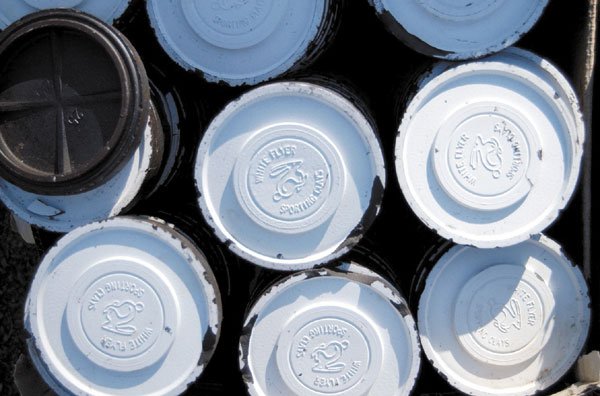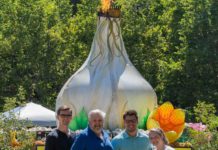Age, gender and physical size don’t mean much in trap and skeet
shooting. What matters is that you’re having fun
Five years ago, Bob Graves was driving home to Morgan Hill one night when he spotted some lights off U.S. 101 and decided to check it out. He hasn’t been able to stop going back since.
Unsure of what to expect, the former professional cowboy discovered a new love: the shooting range.
The people there were nice. They showed him how to shoot and have a good time. Now, Graves shoots skeet and trap every day at Field Sports Park in South San Jose, or what people “in the know” refer to as Metcalf. He’s one of the many people discovering – or in some cases, rediscovering – the county’s park.
“We’re now starting to get the guys who shot here 10 years ago,” said senior rangemaster Otto Bartholdi. “They’re starting to filter back in, hearing that we’re open.”
The range first opened in 1978 but closed in 1992 for environmental testing. The skeet and trap range was closed for six years. In the meantime, Bartholdi started seeing some of the shotguns of former regulars for sale in specialty shops.
“They were tired of waiting for us to reopen,” he said.
Metcalf reopened on a larger scale in March of 2000 and has been experiencing steady growth since, Bartholdi said.
“It’s a sport you really don’t need a lot of equipment for. It’s a big social thing,” he said. “You can spend $20 on ammunition and rounds, and spend eight hours here and never be bored. … These games are great for beginners who want to learn how to shoot. A lot of (people) get hooked for life. What keeps them in the game is that striving for perfection when you don’t miss any.”
The sport is not for the weak, nor is it for the strong, the youthful or the old – it’s for everyone, Bartholdi said.
“There’s no advantage to being young and fit. You can do this all your life,” he explained.
One thing that does help, however, is to have good hand-eye coordination, Bartholdi said.
All of his family members now shoot, including his wife, daughters and son. He is a member of three shooting leagues at Metcalf and competes professionally. In the first competition he entered, Bartholdi said he didn’t know what to expect from the other shooters.
“I was looking around, and you have people of every stature and age,” he said. “Then they played the National Anthem and everyone stood up – little children who could barely walk, older people – honoring our flag. It was the most amazing thing I ever saw.”
If he ever stops shooting, Bartholdi said he’ll still come to the range for the people.
“I’ve never met a person I didn’t like, and I’ve never met someone who wasn’t willing to help a new shooter,” he said.
Tom Ebert created the same welcoming atmosphere when he opened Coyote Valley Sporting Clays in Morgan Hill 23 years ago.
“I wanted to do something that I really felt passionate about, that I really loved,” he said.
Ebert has channeled that love into the 50-acre public site. Cows graze out in the pastures, seemingly mere yards from the skeet and trap stations. Winding dirt trails lead to scenic overviews of the hillsides and additional sporting clay stations.
Every week, he changes the set up of the 15 stations so the experience is never quite the same.
“We still have lots and lots of new customers, and most of them say, ‘Oh, I never knew you were here,'” Ebert said. “We’ve gotten that (since) the first day. There’s still just a lot of people who don’t know about us.”
But looking around the range on a Thursday afternoon, it’s apparent a lot of people do know about them. Nearly every station is occupied. Teens come after school for practice. Retirees come to enjoy the sunshine and the company.
Coyote Valley has about 400 members from everywhere from Hollister and Salinas to San Francisco and Livermore. Most people who come to shoot, however, are not members. And many of the new shooters are women.
“This is the fastest growing sport among women and young girls,” said shooting instructor Bob Popenhager.
This includes Popenhager’s wife, Irene.
“When he first took me to shoot, I was like, ‘I am not going to like this,'” she said. “This was just something I just started out saying, ‘Oh, I’ll just keep score.'”
Learning how the gun felt when it fired took some getting used to, Irene said. So did hitting the clay pigeons.
Now, it’s missing the “birds” that is unusual for her. She is the best female shot at Coyote Valley and belongs to a league at Metcalf. During a recent afternoon practice, she beat an all-male group.
“Pull,” she yelled while standing at the skeet station, holding the shotgun at her waist.
Seconds later, neon orange clay pigeons were flying through the air, most of them bursting into pieces in the sky. One floated softly to the ground, breaking on impact and decorating the green hillsides. A puff of smoke rose off the barrel.
“It really became a passion for me,” she said, walking away from the station with a smile.
Want to learn how to shoot?
Thursdays are the best nights for public use at Field Sports Park. Anyone interested in joining one of the more than 20 squads in the skeet and trap leagues is encouraged to drop by the range, located at 9580 Malech Road in San Jose.
Call (408) 463-0769 for the skeet and trap range office, and (408) 463-0652 for the rifle and pistol range office. The range’s Web site is www.parkhere.org.
Coyote Valley Sporting Clays is located at 1000 San Bruno Ave. in Morgan Hill. Call (408) 778-3600 or go to
www.coyoteclays.com.














